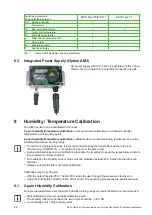
31
EE33 Humidity / Temperature Sensor for High Humidity and Chemical Applications
5.
Connect the test unit to the supply connections of HUMOR 20.
6.
Connect the output signal of the test unit(s) to the internal measuring
inputs of HUMOR 20 (Unit1 RH, Unit2 RH).
7.
Select the measuring ranges in accordance with the output signal of the
test units. The temperature of the measuring chamber can be displayed
by selecting "Temp." on the measuring range switch.
8.
Use the humidity controller to select the setpoint of the humidity.
9.
For information on the standard deviations and stabilisation times of the
test unit, refer to the manufacturer's documentation (however, a
minimum of 20 mins is recommended).
10. Compare the values shown in the display with the output signal of the
sensor.
After calibration, make sure that the plugs in the air vents in the cover of the measuring chamber are
removed.
9.6.2
Adjustment/Calibration with Various Calibrators
For an exact calibration, note especially point 4 in the chapter above.
10 Maintenance
10.1 Sensor Cleaning
It is easy to clean the sensor if there are particle deposits (e.g. dust) on the surface of the heated
measurement cell.
Commercially available isopropyl alcohol is used for cleaning. Unscrew the filter cap and submerge the
sensor element in the alcohol for 2 minutes.
Allow the sensor element to dry or blow it dry with oil-free compressed air.
Caution: In order to avoid destroying the active sensor coating, avoid using mechanical aids (e.g. cotton
swabs or cloths) for cleaning!
10.2 Automatic ReCovery (ARC)
When capacitive humidity sensors are exposed to chemical pollution (e.g. detergent
residue), the presence of foreign molecules can distort the measurement reading.
The foreign molecules can be evaporated by heating the measurement cell briefly and intensively.
Reconditioning helps to minimize distorted measurement readings during the calibration interval.
It is recommended to heat the measurement cell by choosing Manual after the cleaning or sterilization
process or if distorted measurement readings are suspected.
To start heating, remove the housing cover and press the pushbutton S3 or trigger the ARC-module with
the external signal (see chapter 8.1 “ARC-Module (Option AM1)”.
The orange LED D3 is illuminated during heating.
























